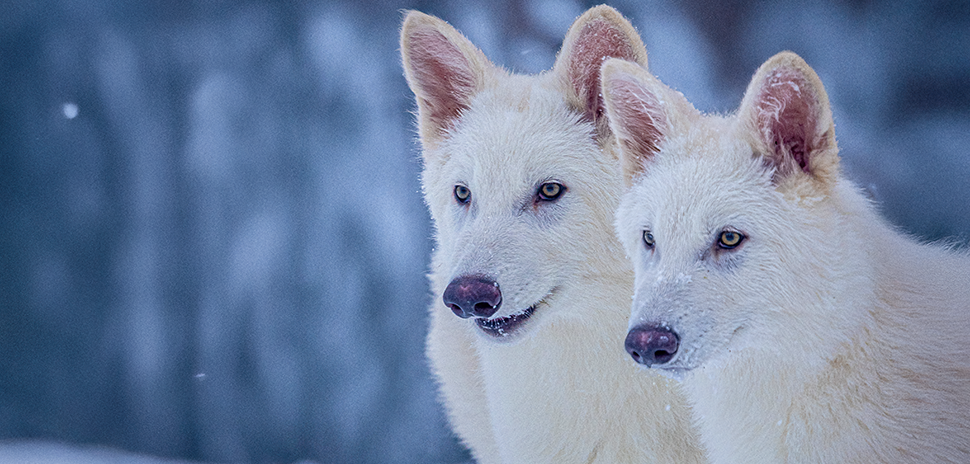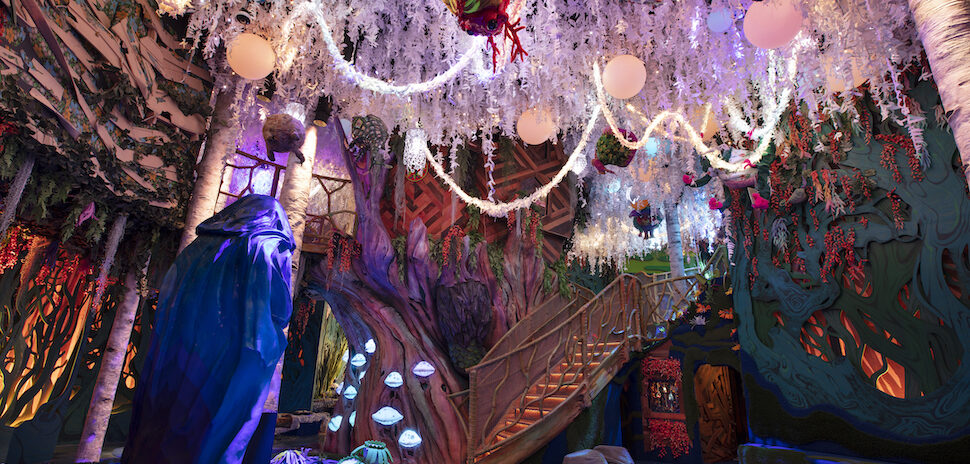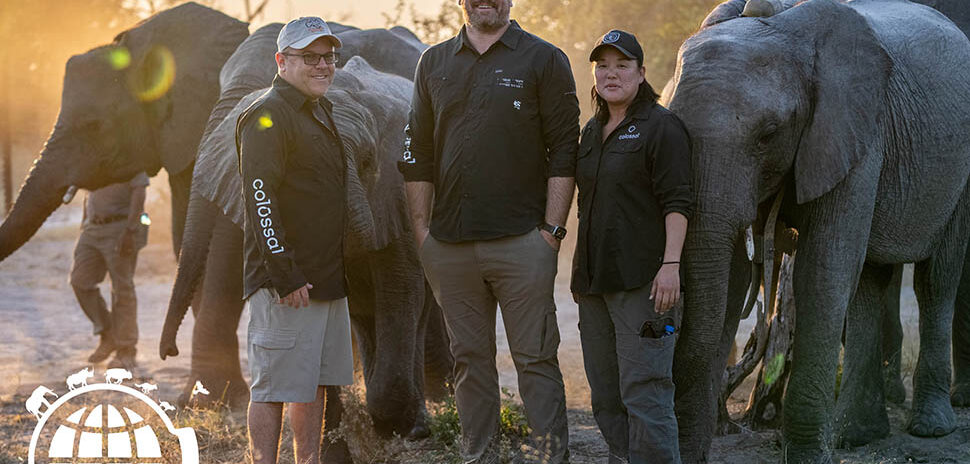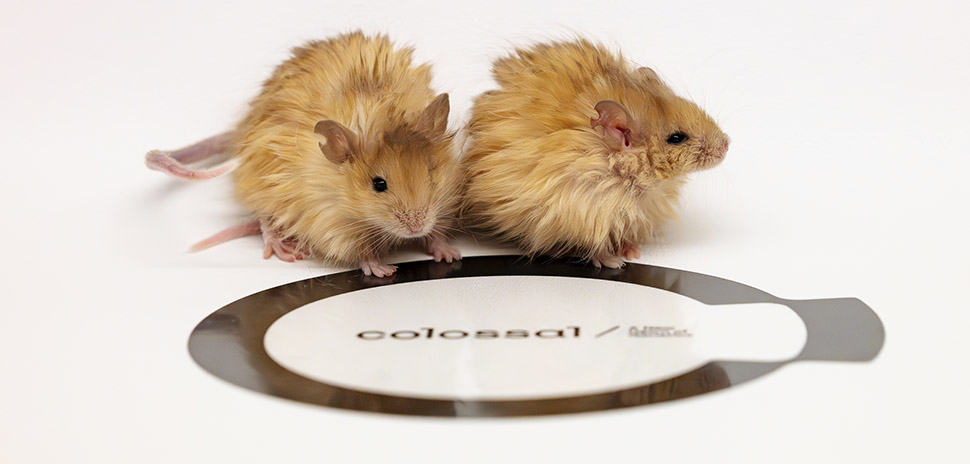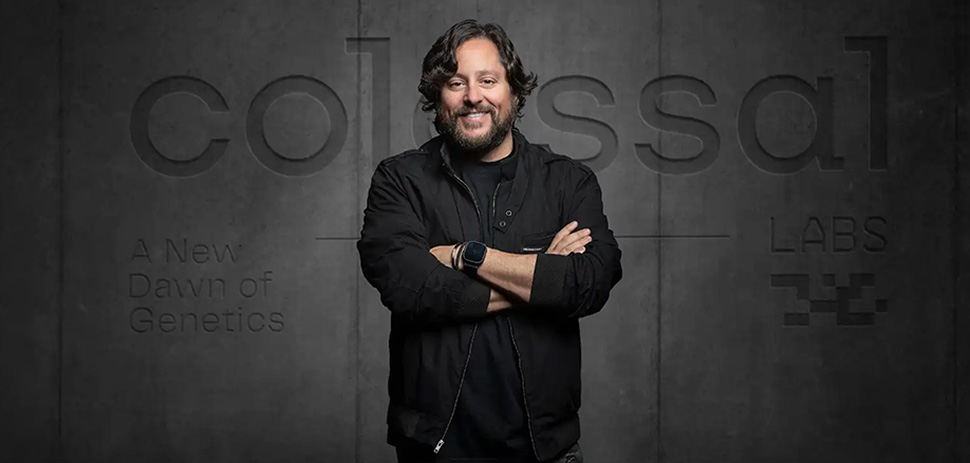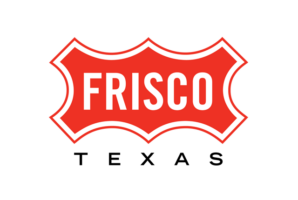A sound not heard on Earth for more than 12,500 years is back. The howl of a dire wolf—extinct since before recorded history and known to most through “Game of Thrones”—has returned, according to Dallas-based Colossal Biosciences.
The company announced today the successful birth of three dire wolves, calling it the world’s first true de-extinction. It’s a scientific milestone that represents a leap forward for Colossal—Texas’ first decacorn—in the genetic innovation race.
The pups—two males named Romulus and Remus, now six months old, and a younger female named Khaleesi, who is three months—are already exhibiting early pack behavior.

Click the image to watch (and listen) to the first dire wolf howl in more than 10,000 years. [Screenshot: Colossal Video]
Founded in 2021 by entrepreneur Ben Lamm and Harvard geneticist George Church, Colossal’s moonshot mission to bring back species like the woolly mammoth, thylacine, and dodo is backed by more than $435 million in funding and now valued at $10.2 billion. In just four years, the company has grown into a global biotech operation with more than 170 scientists working across labs in Dallas, Boston, and Melbourne.
Now, the sound coming out of Dallas is global noise—with Colossal capturing headlines and imaginations from The New York Times, Wired, and TIME to Bloomberg, Hollywood Reporter, and the Daily Mail. The Dallas company has had a quick succession of public breakout moments this year, crossing from mainstream media into pop culture, as it presses ahead with its sci-fi-sized ambitions.
Colossal CEO Ben Lamm—who landed on the Forbes billionaire list last week—calls it just the beginning.
The dire wolf breakthrough builds on Colossal’s work on species like the woolly mammoth and, most recently, the genetically engineered woolly mouse—a long-haired mouse modified to test traits for surviving extreme cold. That project held the record for genome edits in a vertebrate at eight. The wolf work blows past it with 20, including 15 extinct gene variants brought back from ancient DNA.

Watch the video: One of Colossal’s historic dire wolves catches a nap after an active play session. Dallas-based Colossal Biosciences says it has successfully brought back the dire wolf after 12,500 years of extinction, using DNA from fossils up to 72,000 years old. A short video traces these groundbreaking animals—named Romulus, Remus, and Khaleesi—from their first wobbly steps as 15-day-old pups to their distinctive howls, a sound not heard on Earth since before recorded history. [Video: Colossal Biosciences]
“I could not be more proud of the team,” said Lamm in a statement. “This massive milestone is the first of many coming examples demonstrating that our end-to-end de-extinction technology stack works. Our team took DNA from a 13,000-year-old tooth and a 72,000-year-old skull and made healthy dire wolf puppies.”
“It was once said, ‘any sufficiently advanced technology is indistinguishable from magic.’ Today, our team gets to unveil some of the magic they are working on and its broader impact on conservation.”
Bringing ancient DNA to life
The dire wolf, once a predator that roamed across North America during the Pleistocene ice ages, went extinct around 13,000 years ago. Now, through the work of Colossal, the company says these animals are once again taking their first steps in a world they haven’t inhabited for millennia.
Bringing them back was a bit like reconstructing a lost recipe—then baking it with modern ingredients.
![The team behind the howl: Colossal Co-founder and CEO Ben Lamm, Chief Science Officer Beth Shapiro, and Co-Founder George Church are at the forefront of the world’s first true de-extinction effort. [Photo: Colossal]](https://s24806.pcdn.co/wp-content/uploads/2025/04/BenBethGeorge.png)
The team behind the howl: Colossal Co-founder and CEO Ben Lamm, Chief Science Officer Beth Shapiro, and Co-Founder George Church are at the forefront of the world’s first true de-extinction effort.
[Photo: Colossal]
At the heart of Colossal’s dire wolf achievement is Chief Science Officer Beth Shapiro, a recognized leader in ancient DNA research. Her innovative approaches to paleogenome reconstruction have fundamentally changed what’s possible in de-extinction science.
“Our novel approach to iteratively improve our ancient genome in the absence of a perfect reference sets a new standard for paleogenome reconstruction,” said Shapiro.
Her team faced a monumental challenge: how to reassemble a complete genome from DNA fragments that had degraded over tens of thousands of years.
From fossil fragments to full genome
Working with two ancient specimens—a tooth from Ohio and an ear bone from Idaho—Shapiro’s team developed computational tools that achieved 500 times more coverage of the dire wolf genome than had ever been recorded.
For years, scientists debated the dire wolf’s closest living relative. Some believed it was the jackal. But Shapiro’s analysis found that gray wolves share 99.5% of their DNA with dire wolves. Her team also discovered that dire wolves emerged from the hybridization of two ancient canid lineages between 3.5 and 2.5 million years ago.
Shapiro’s genome analysis surfaced physical traits that bones alone couldn’t show—such as coat color. Genetic markers suggested that dire wolves likely had white or light-colored coats, an insight previously out of reach.

[Image: Colossal]
A safer path to de-extinction
When it came time to edit the genome, Shapiro’s team didn’t simply copy ancient DNA. Instead, they used a “functional de-extinction” approach, analyzing how extinct gene variants would interact with modern DNA to avoid harmful effects.
“We turn to ancient DNA to learn as much as we can about each species and, whenever possible, to link specific extinct DNA sequence variants to each key trait,” Shapiro said. “In some cases, we learn that variants already present in the surrogate species can be used to engineer that key trait.”
As Shapiro puts it, these advances allowed her team “to resolve the evolutionary history of dire wolves and establish the genomic foundation for de-extinction”—a foundation she believes could help save endangered species today.
From prehistory to howling reality
The result: healthy dire wolf pups that combine ancient gene traits with a carefully selected modern genetic background. Colossal says they are structurally larger than modern gray wolves and covered in thick fur, the animals reflect the traits shaped by an Ice Age environment
“Many people view dire wolves as mythical creatures that only exist in a fantasy world, but in reality, they have a rich history of contributing to the American ecosystem,” said Game of Thrones creator and author George R.R. Martin, who is a Colossal investor and cultural advisor. “I get the luxury to write about magic, but Ben and Colossal have created magic by bringing these majestic beasts back to our world.”

[Photo: Colossal]
Beyond fantasy: Real-world conservation impact
While the dire wolf captures the public imagination, Colossal says the breakthrough also advances efforts to save species on the edge of extinction today.
The company has successfully cloned and birthed two litters of red wolves—North America’s most critically endangered canid, with fewer than 20 left in the wild. Using a non-invasive blood cloning technique known as EPC (endothelial progenitor cell) cloning, Colossal produced one female red wolf named Hope and three male pups—Blaze, Cinder, and Ash—from three distinct founder lines.
According to the company, the births could boost the genetic diversity of the red wolf population by 25%.
“Preserving, expanding, and testing genetic diversity should be done well before important endangered animal species like the red wolf are lost,” said Colossal co-founder and Harvard geneticist George Church.

Adolescent red wolf [Photo: Colossal]
Ghost wolves and genetic rescue
Colossal’s red wolf work also supports efforts to map the lingering genetic legacy of red wolves in the American South. So-called “ghost wolves”—hybrid canids in Texas and Louisiana—carry ancestral red wolf DNA, and Colossal is working with researchers, including Princeton’s Dr. Bridgett vonHoldt and the Gulf Coast Canine Project, to study and preserve these rare alleles.
“Perfecting genomic tools to integrate ‘ghost alleles’ from Gulf Coast canids would increase red wolf genetic diversity and generate knowledge for recovering other imperiled species,” said Mike Phillips, director of the Turner Endangered Species Fund.
Home on the ecological preserve
Colossal says the wolves are thriving on a secure 2,000-acre ecological preserve that’s certified by the American Humane Society and registered with the USDA, according to Colossal. The property includes open acreage for roaming, wooded areas, and a specialized six-acre habitat where the wolves are gradually acclimating to outdoor life and learning the rhythms of the wild.
Their core zone features natural dens, a storm shelter, and an on-site veterinary clinic. The animals are monitored 24/7 using drone surveillance, live cameras, and on-site security staff. Colossal employs ten full-time animal care professionals, including specialists in exotic and canid care, to ensure the wolves’ health and well-being.
“Optimal welfare is evidenced by spacious habitats with ample opportunity for animals to socialize, exercise, and exhibit natural behaviors,” said Robin Ganzert, president and CEO of the American Humane Society, which certifies the facility.

[Rendering: Colossal]
From conservation to rewilding
Colossal’s long-term goal isn’t just to bring species back—it’s to return them to the ecosystems they once helped shape. That means moving beyond the lab toward rewilding: behavioral independence, environmental adaptation, and eventual reintegration into protected wild habitats.
For red wolves—North America’s most endangered canid—the company envisions reintroduction through existing U.S. conservation frameworks, working in coordination with federal agencies, scientists, and Indigenous communities.
“True success,” CEO Ben Lamm told Dallas Innovates earlier this year, “is successfully having a group of these different species that have enough genetic diversity engineered into them that we can successfully work with Indigenous people groups, private landowners and local governments to rewild those species back into the wild in that they’re thriving.”
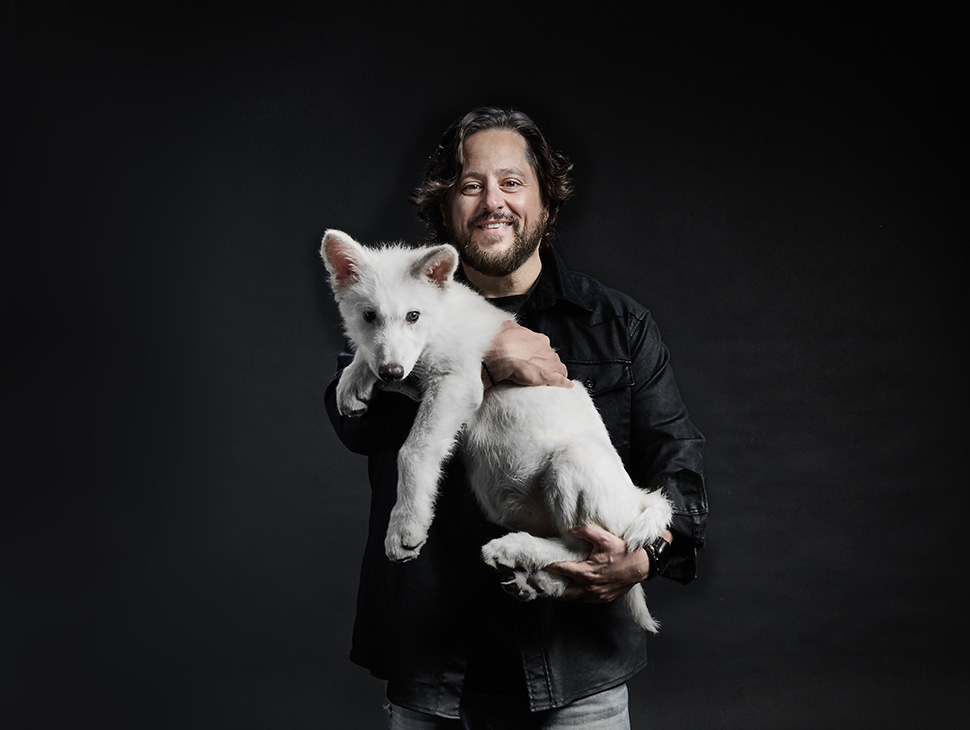
Ben Lamm with Khaleesi [Photo: Colossal]
That philosophy runs through Colossal’s broader work. “The technologies developed on the path to the dire wolf are already opening up new opportunities to rescue critically endangered canids,” said Chief Animal Officer Matt James.
He points to tools like Colossal’s EPC blood-cloning platform—an advance that allows scientists to collect and replicate DNA with far less disruption, making widespread biobanking efforts more scalable across conservation science.
Partnerships and the spirit of rewilding
Colossal sees rewilding as a scientific and cultural responsibility. Many partners fuel the company’s initiatives, including the American Wolf Foundation, Re:wild, Conservation Nation, Gulf Coast Canid Project, International Coexistence Network, Wolf Connection, Grizzly Systems, and the Yellowstone Wolf Project.
The company also has developed long-term partnerships with Indigenous communities across North America—including the MHA Nation, the Nez Perce Tribe, the Karankawa Tribe of Texas, INDIGENOUS LED, and the Wind River Tribal Buffalo Initiative. The relationships are active, not ceremonial, with Indigenous leaders contributing ecological knowledge and cultural insight to Colossal’s strategy.
“The de-extinction of the dire wolf is more than a biological revival,” said MHA Nation Tribal Chairman Mark Fox. “Its birth symbolizes a reawakening—a return of an ancient spirit to the world. The dire wolf carries the echoes of our ancestors, their wisdom, and their connection to the wild.”
As the wolves are monitored and observed to assess their readiness to move into larger protected and managed care facilities, they could potentially be located on Indigenous land.
“The ability for technological innovation to bring forth something so culturally and spiritually significant to Indigenous people,” Fox added, “is paralleled by the far-reaching impacts that this technology provides for the future of stewardship on our planet in species diversity and conservation.”
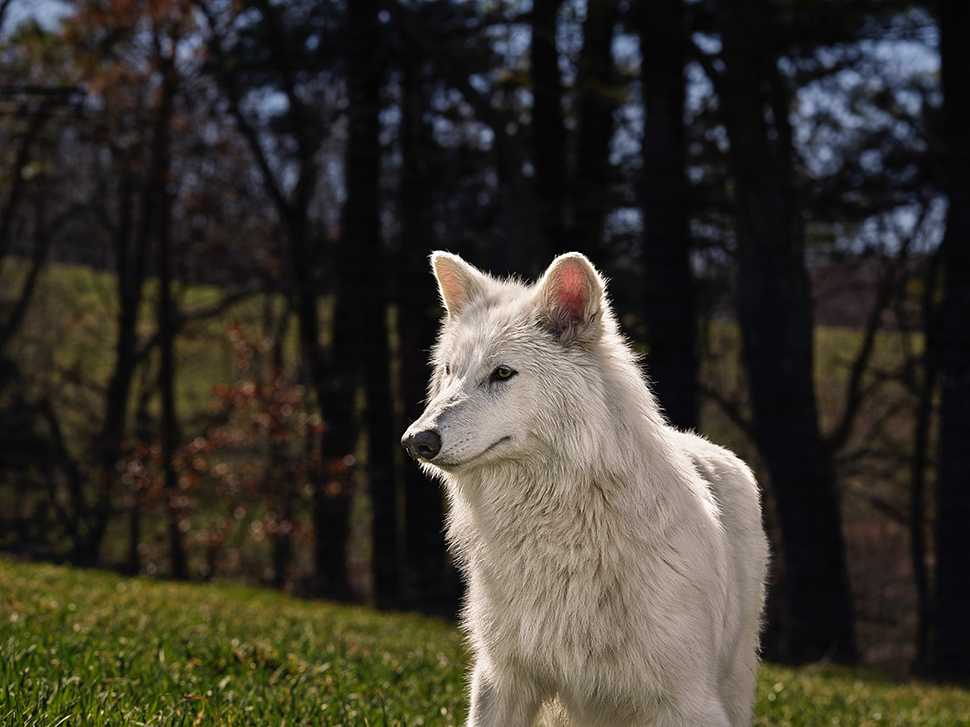
5-month-old dire wolf [Photo: Colossal]
A new era of human stewardship
As Colossal’s breakthrough ripples through scientific and conservation circles, its implications extend beyond the return of a single species, according to experts like Christopher Mason, a scientific advisor and member of the board of observers for Colossal.
“The de-extinction of the dire wolf and an end-to-end system for de-extinction is transformative and heralds an entirely new era of human stewardship of life,” he said in a statement. “This is an extraordinary technological leap in genetic engineering efforts for both science and for conservation—and a wonderful example of the power of biotechnology to protect species, both extant and extinct.”
Colossal’s de-extinction efforts are designed with real-world ecological restoration in mind—particularly as research shows that reintroducing apex predators like wolves can rebalance ecosystems, support biodiversity, and even help mitigate climate change.

Baby red wolf [Screenshot: Colossal video]
Inspired in part by the U.S. Fish and Wildlife Service’s efforts to rescue the critically endangered red wolf, Colossal has developed tools that could accelerate recovery for species teetering on the edge.
“Today’s dire wolf announcement represents an exciting scientific step and demonstrates the power and possibilities of genetic technologies,” said Barney Long, senior director of conservation strategy for Re:wild. “These technologies will likely transform the conservation of critically endangered species that still exist, and we are excited to apply them to prevent extinctions.”
“From restoring lost genes into small, inbred populations to inserting disease resistance into imperiled species,” Long added, “the genetic technologies being developed by Colossal have immense potential to greatly speed up the recovery of species on the brink of extinction.”
In the months ahead, the company plans to share more details on both its red wolf rescue and dire wolf restoration programs—backed by continued feasibility studies, health monitoring, and habitat planning.
For now, Colossal is letting the first dire wolf howl echo—into science, into conservation, and into what comes next.

Dire wolf [Screenshot: Colossal video]
“One of the things that gives me hope”
For historian and author Dan Flores, whose work has explored the ecological and cultural history of wolves and coyotes, the moment taps a deeper level.
“As someone who’s fascinated with canids—I’ve written about coyotes and wolves—the idea of being able to have dire wolves again is tremendously, personally exciting, and I think it’s going to be exciting to a lot of people,” said Flores, A. B. Hammond Professor Emeritus of the History of the American West at the University of Montana-Missoula.
“An organization like Colossal, to me, is one of the things that gives me hope. If I were looking 100 years out, I would say that we’re very likely to have animals once again that we thought were always gone—just as I once thought I was never going to get to hear a wolf howl. That was something I really never thought I’d have a chance to experience, and it became reality.”
“And so, that makes me think that more and more, we’re going to get to experience what Henry David Thoreau lamented back in the 1850s—that he wasn’t getting to experience an entire heaven and an entire Earth. And I think that’s something to look forward to.”
Don’t miss what’s next. Subscribe to Dallas Innovates.
Track Dallas-Fort Worth’s business and innovation landscape with our curated news in your inbox Tuesday-Thursday.

